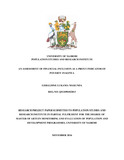| dc.description.abstract | The study aimed at assessing to what extent financial inclusion is related to poverty and determine whether it can be used as an indicator to monitor poverty levels at the household level.
The main data source was the National FinAccess household 2016 survey. The main analysis was done using SPSS statistical tools primarily, cross tabulations, logistical regressions and the Principal Component Analysis (PCA). Financial inclusion in Kenya has changed over the years and this is tracked approximately every three years by the government of Kenya. The financial inclusion levels have changed from 2006 with 58.8% of adults financially included then to 82.2% in 2016 and these vary across different demographics and socio-economic groups. The measure of financial inclusion is directly measurable in a simple manner and is done at least every three years. Financial inclusion, just like poverty, is a multidimensional measure. The study focused on three key financial indicator measures – access, usage and quality. There was a clear difference in access and usage indicators among the different wealth levels but no clear difference in the quality related financial inclusion indicators. The most important indicators identified were awareness of terms, usage of financial services especially mobile money and use of future oriented services – insurance, savings and pensions. Different models were generated to determine how the models could predict the level of poverty as well as determine their purity. The models can be used as poverty proxies because they are significantly associated with financial inclusion or exclusion variables. They would also act as good proxies as no single indicator can be used, being multi-dimensional in nature. For the financial indicators to work better, they need to take into consideration other variables of the population such as level of education, age, location and gender. The association is still stronger even when control variables are included. The financial inclusion factors can act as good discriminators between poor and non-poor. National poverty studies in most developing countries like Kenya are done after a long period, almost after a decade. These in most cases leave policy makers, researchers, the private sector and development practitioners with no option but to use outdated information. National financial inclusion studies, which are easier and less costly to undertake, are being undertaken more frequently and can be used as proxy poverty indicators. However, more needs to be studied to determine which would be the most ideal indicators to use including exploring the welfare aspect of financial inclusion which was excluded from the study. | en_US |



